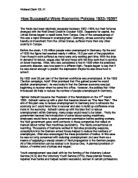Michael Clark 13LH1
How Successful Were Economic Policies 1933-1939?
The Nazis had been relatively unpopular between 1923 -1928, but their fortunes changed with the Wall Street Crash in October 1929. Desperate for capital, the United States began to recall loans from Europe. One of the consequences of this was a rapid increase in unemployment. Germany, whose economy relied heavily on investment from the United States, suffered more than any other country in Europe.
Before the crash, 1.25 million people were unemployed in Germany. By the end of 1930 the figure had reached nearly 4 million, 15.3 per cent of the population. Even those in work suffered as many were only working part-time. With the drop in demand for labour, wages also fell and those with full-time work had to survive on lower incomes. Hitler, who was considered a fool in 1928 when he predicted economic disaster, was now seen in a different light. People began to say that if he was clever enough to predict the depression maybe he also knew how to solve it.
By 1932 over 30 per cent of the German workforce was unemployed. In the 1933 Election campaign, Adolf Hitler promised that if he gained power he would abolish unemployment. He was lucky in that the German economy was just beginning to recover when he came into office. However, the policies that Hitler introduced did help to reduce the number of people unemployed in Germany.
Hjalmar Schacht became the President of the Reichsbank on the 17th March 1933. Schacht came up with a plan that became known as ‘The New Plan.’ The aim of this plan was to reduce unemployment in Germany and to stimulate the economy so it could have time to recover and also to build up confidence once more in the economy. Schacht came up with the idea that to reduce unemployment within Germany, many steps would need to be taken. Firstly the government banned the introduction of some labour-saving machinery, employers would have to seek government permission before sacking workers, the Nazi government gave work contracts to those companies that relied on manual labour rather than machines (autobahn). The Nazis concentrated on rearming. Thousands of Germans worked in factories producing weapons, conscription into the German armed forces helped to reduce the numbers of unemployed, Hitler also encouraged the mass production of radios. In this case he was not only concerned with reducing unemployment, but saw them as a means of supplying a steady stream of Nazi propaganda to the German people. All of this information can be related to in Source One, ‘A planned provision of labour, of market and of prices and wages.’







